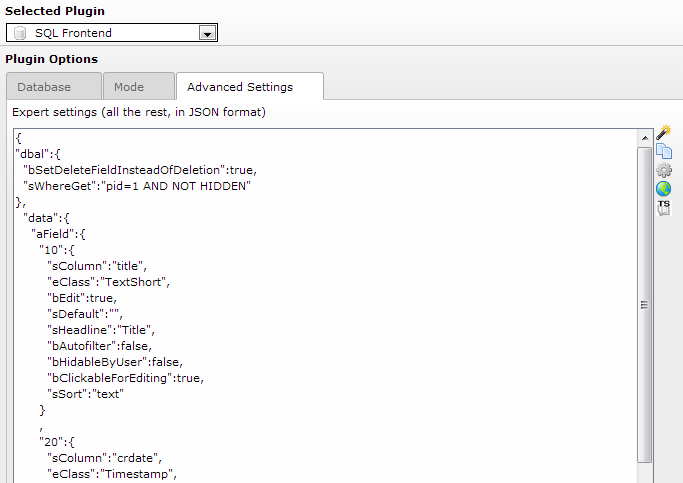DEPRECATION WARNING
This documentation is not using the current rendering mechanism and is probably outdated. The extension maintainer should switch to the new system. Details on how to use the rendering mechanism can be found here.
Configuration¶
Target group: Administrators, Editors
There are four ways in total (three of them for you) to configure a SQL Frontend:
- PHP-coded default configuration (this is not for you, but you should know, that there is something basic beyond everything)
- TypoScript-based configuration (TS setup; wherever you need it; it's recommended to maintain configuration for more than one SQL Frontend in one general place)
- the content element's basic settings (they are easy)
- the content element's advanced settings (where everything can be messed up again)
Except in the content element's basic settings, all configuration can be specified in all the mentioned locations. And they overrule each other in the corresponding order. Thus, PHP default settings are overwritten by TS which is overwritten by basic settings within the content element, and finally this is overruled by advanced settings.
Got it? There's something basic you could overwrite using TS. This then applies to all SQL Frontends which are (speaking page-tree inheritance) affected by this TS setup. If you now include a new SQL Frontend plugin, you may overwrite the specified settings with the backend flexform controls. And if you need something special for this very single SQL Frontend, you could finally use the content element's advanced settings.
So all configuration ways are working together, for one bigger goal: Configure one or many SQL Frontend(s). Anyhow, they have (due to their nature and to performance reasons) different formats to be configured in:
- PHP: one big associative array
- TypoScript: it's TS setup, separated as objects (that's just regular TS)
- content element's basic settings: easy, just fill the form
- content element's advanced settings: difficult indeed, it's JSON (!)

This looks nasty, I know. Anyhow, it's fast. And it allows us to configure exactly the way we need it. And there are a few wizards located next to the input field that should help you get the JSON config right.
Okay, now you got it. Right? Good. Let's take a look at the configuration itself. It is organized as one huge configuration collection (PHP: array, TS: object, content element: json) with four basic areas:
- within dbal (database abstraction layer) all data-source-related issues are configured
- data included everything related to the output of the, well, data
- currently not really configurable is transmission which allows configuration of the communication between server/client
- finally, you could always add own adjustments within interception
And what to configure within these areas? Let's take a closer look at all of them.
- dbal
- data
- data: Table
- data: CSV
- data: Xlsx
- data: Detail
- data: Form
- data: Manual
- transmission
- interception
- AggregateToBarChart
- AggregateToList
- Calculate
- Live calculation during form input
- ClearCache
- Code
- CountSubEntries
- CreateId
- CsvImport
- DeletionBasedOnRowData
- ListSubEntries
- Lookup
- Passwordify
- ReconfigureIf
- ReplaceMarkerWithImages
- RewriteEditLinkBasedOnRowData
- String
- Timestamp
- UpdateField
- UpdateTable